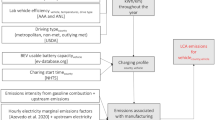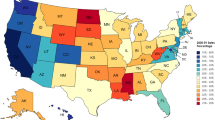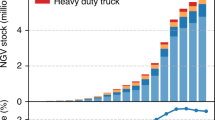Abstract
Climate change mitigation strategies are often technology-oriented, and electric vehicles (EVs) are a good example of something believed to be a silver bullet. Here we show that current US policies are insufficient to remain within a sectoral CO2 emission budget for light-duty vehicles, consistent with preventing more than 2 °C global warming, creating a mitigation gap of up to 19 GtCO2 (28% of the projected 2015–2050 light-duty vehicle fleet emissions). Closing the mitigation gap solely with EVs would require more than 350 million on-road EVs (90% of the fleet), half of national electricity demand and excessive amounts of critical materials to be deployed in 2050. Improving average fuel consumption of conventional vehicles, with stringent standards and weight control, would reduce the requirement for alternative technologies, but is unlikely to fully bridge the mitigation gap. There is therefore a need for a wide range of policies that include measures to reduce vehicle ownership and usage.
This is a preview of subscription content, access via your institution
Access options
Access Nature and 54 other Nature Portfolio journals
Get Nature+, our best-value online-access subscription
$29.99 / 30 days
cancel any time
Subscribe to this journal
Receive 12 print issues and online access
$209.00 per year
only $17.42 per issue
Buy this article
- Purchase on Springer Link
- Instant access to full article PDF
Prices may be subject to local taxes which are calculated during checkout



Similar content being viewed by others
Data availability
The datasets generated during the study are available in a Zenodo repository (https://doi.org/10.5281/zenodo.3982990) (ref. 60).
Code availability
The source code for the model developed in this study can be accessed on request. It uses the open-source Fleet Life Cycle Assessment and Material-Flow Estimation (FLAME) model, available in a Zenodo repository (https://doi.org/10.5281/zenodo.2548012)61.
References
CO2 Emissions from Fuel Combustion 2019 (International Energy Agency, 2019).
Inventory of US Greenhouse Gas Emissions and Sinks (US Environmental Protection Agency, 2019).
Creutzig, F. et al. Towards demand-side solutions for mitigating climate change. Nat. Clim. Change 8, 268–271 (2018).
Leard, B., Linn, J. & Munnings, C. Explaining the evolution of passenger vehicle miles traveled in the United States. Energy J. 40, 25–54 (2019).
World Energy Outlook 2018 Executive Summary (International Energy Agency, 2018).
Global EV Outlook 2019: Scaling up the Transition to Electric Mobility (International Energy Agency, 2019).
2018 Multi-State ZEV Action Plan: Accelerating the Adoption on Zero Emission Vehicles (Multi-State ZEV Task Force, 2018).
Zero Emission Vehicle (ZEV) Program (Colorado Department of Public Health and Environment, 2019).
Ellingsen, L. A.-W., Singh, B. & Strømman, A. H. The size and range effect: lifecycle greenhouse gas emissions of electric vehicles. Environ. Res. Lett. 11, 054010 (2016).
Cox, B., Mutel, C. L., Bauer, C., Mendoza Beltran, A. & van Vuuren, D. P. Uncertain environmental footprint of current and future battery electric vehicles. Environ. Sci. Technol. 52, 4989–4995 (2018).
Marmiroli, B. et al. Electricity generation in LCA of electric vehicles: a review. Appl. Sci. 8, 1384 (2018).
Wu, D. et al. Regional heterogeneity in the emissions benefits of electrified and lightweighted light-duty vehicles. Environ. Sci. Technol. 53, 10560–10570 (2019).
Milovanoff, A. et al. A dynamic fleet model of US light-duty vehicle lightweighting and associated greenhouse gas emissions from 2016 to 2050. Environ. Sci. Technol. 53, 2199–2208 (2019).
Martin, N. P. D., Bishop, J. D. K. & Boies, A. M. How well do we know the future of CO2 emissions? Projecting fleet emissions from light duty vehicle technology drivers. Environ. Sci. Technol. 51, 3093–3101 (2017).
The Safer Affordable Fuel Efficient (SAFE) Vehicles Proposed Rule for Model Years 2021–2026 (National Highway Traffic Safety Administration & Environmental Protection Agency, 2018).
Keith, D. R., Houston, S. & Naumov, S. Vehicle fleet turnover and the future of fuel economy. Environ. Res. Lett. 14, 021001 (2019).
Trancik, J. E., Chang, M. T., Karapataki, C. & Stokes, L. C. Effectiveness of a segmental approach to climate policy. Environ. Sci. Technol. 48, 27–35 (2014).
Matthews, H. D., Gillett, N. P., Stott, P. A. & Zickfeld, K. The proportionality of global warming to cumulative carbon emissions. Nature 459, 829–832 (2009).
Melaina, M. W. & Webster, K. Role of fuel carbon intensity in achieving 2050 greenhouse gas reduction goals within the light-duty vehicle sector. Environ. Sci. Technol. 45, 3865–3871 (2011).
Winkler, S. L., Wallington, T. J., Maas, H. & Hass, H. Light-duty vehicle CO2 targets consistent with 450 ppm CO2 stabilization. Environ. Sci. Technol. 48, 6453–6460 (2014).
Meier, P. J. et al. Potential for electrified vehicles to contribute to US petroleum and climate goals and implications for advanced biofuels. Environ. Sci. Technol. 49, 8277–8286 (2015).
Miotti, M., Supran, G. J., Kim, E. J. & Trancik, J. E. Personal vehicles evaluated against climate change mitigation targets. Environ. Sci. Technol. 50, 10795–10804 (2016).
Grimes-Casey, H. G., Keoleian, G. A. & Willcox, B. Carbon emission targets for driving sustainable mobility with US light-duty vehicles. Environ. Sci. Technol. 43, 585–590 (2009).
O’Neill, B. C. et al. The roads ahead: narratives for shared socioeconomic pathways describing world futures in the 21st century. Glob. Environ. Change 42, 169–180 (2017).
Robinson, J. B. Energy backcasting: a proposed method of policy analysis. Energ. Policy 10, 337–344 (1982).
Calvin, K. et al. GCAM v5.1: representing the linkages between energy, water, land, climate, and economic systems. Geosci. Model Dev. 12, 677–698 (2019).
Schivley, G., Azevedo, I. & Samaras, C. Assessing the evolution of power sector carbon intensity in the United States. Environ. Res. Lett. 13, 064018 (2018).
Annual Energy Outlook 2019. US Energy Information Administration https://www.eia.gov/outlooks/aeo/ (2019).
Muratori, M. Impact of uncoordinated plug-in electric vehicle charging on residential power demand. Nat. Energy 3, 193–201 (2018).
Sioshansi, R. & Denholm, P. Emissions impacts and benefits of plug-in hybrid electric vehicles and vehicle-to-grid services. Environ. Sci. Technol. 43, 1199–1204 (2009).
Zubi, G., Dufo-López, R., Carvalho, M. & Pasaoglu, G. The lithium-ion battery: state of the art and future perspectives. Renew. Sust. Energ. Rev. 89, 292–308 (2018).
A Federal Strategy to Ensure Secure and Reliable Supplies of Critical Minerals. US Department of Commerce https://www.commerce.gov/news/reports/2019/06/federal-strategy-ensure-secure-and-reliable-supplies-critical-minerals (2019).
National Minerals Information Center. US Geological Survey https://www.usgs.gov/centers/nmic (2020).
Roelich, K. et al. Assessing the dynamic material criticality of infrastructure transitions: a case of low carbon electricity. Appl. Energy 123, 378–386 (2014).
Nansai, K. et al. Nexus between economy-wide metal inputs and the deterioration of sustainable development goals. Resour. Conserv. Recycl. 149, 12–19 (2019).
Ali, S. H. et al. Mineral supply for sustainable development requires resource governance. Nature 543, 367–372 (2017).
Harper, G. et al. Recycling lithium-ion batteries from electric vehicles. Nature 575, 75–86 (2019).
Kushnir, D. & Sandén, B. A. The time dimension and lithium resource constraints for electric vehicles. Resour. Policy 37, 93–103 (2012).
Larcher, D. & Tarascon, J. M. Towards greener and more sustainable batteries for electrical energy storage. Nat. Chem. 7, 19–29 (2015).
Light-Duty Automotive Technology, Carbon Dioxide Emissions, and Fuel Economy Trends Report: 1975 Through 2017 (EPA-420-R-18-001) (US Environmental Protection Agency, 2018).
Whitefoot, K. S. & Skerlos, S. J. Design incentives to increase vehicle size created from the US footprint-based fuel economy standards. Energ. Policy 41, 402–411 (2012).
Luk, J. M., Kim, H. C., De Kleine, R., Wallington, T. J. & MacLean, H. L. Review of the fuel saving, life cycle GHG emission, and ownership cost impacts of lightweighting vehicles with different powertrains. Environ. Sci. Technol. 51, 8215–8228 (2017).
Mackenzie, D., Zoepf, S. & Heywood, J. Determinants of US passenger car weight. Int. J. Veh. Des. 65, 73–93 (2014).
Needell, Z. A., McNerney, J., Chang, M. T. & Trancik, J. E. Potential for widespread electrification of personal vehicle travel in the United States. Nat. Energy 1, 16112 (2016).
Gai, Y. et al. Health and climate benefits of electric vehicle deployment in the greater Toronto and Hamilton area. Environ. Pollut. 265, 114983 (2020).
Reichmuth, D. S., Lutz, A. E., Manley, D. K. & Keller, J. O. Comparison of the technical potential for hydrogen, battery electric, and conventional light-duty vehicles to reduce greenhouse gas emissions and petroleum consumption in the United States. Int. J. Hydrogen Energ. 38, 1200–1208 (2013).
Milovanoff, A., Posen, I. D., Saville, B. A. & MacLean, H. L. Well-to-wheel greenhouse gas implications of mid-level ethanol blend deployment in Canada’s light-duty fleet. Renew. Sust. Energ. Rev. 131, 110012 (2020).
Pacala, S. & Socolow, R. Stabilization wedges: solving the climate problem for the next 50 years with current technologies. Science 305, 968–972 (2004).
Sager, J., Apte, J. S., Lemoine, D. M. & Kammen, D. M. Reduce growth rate of light-duty vehicle travel to meet 2050 global climate goals. Environ. Res. Lett. 6, 024018 (2011).
Axsen, J., Plötz, P. & Wolinetz, M. Crafting strong, integrated policy mixes for deep CO2 mitigation in road transport. Nat. Clim. Change 10, 809–818 (2020).
Wadud, Z., MacKenzie, D. & Leiby, P. Help or hindrance? The travel, energy and carbon impacts of highly automated vehicles. Transp. Res. A 86, 1–18 (2016).
Schmutzler, A. Local transportation policy and the environment. Environ. Resour. Econ. 48, 511–535 (2011).
Mattioli, G. Transport needs in a climate-constrained world. A novel framework to reconcile social and environmental sustainability in transport. Energy Res. Soc. Sci. 18, 118–128 (2016).
van Vuuren, D. P. et al. Energy, land-use and greenhouse gas emissions trajectories under a green growth paradigm. Global Environ. Chang. 42, 237–250 (2017).
Fricko, O. et al. The marker quantification of the Shared Socioeconomic Pathway 2: a middle-of-the-road scenario for the 21st century. Global Environ. Chang. 42, 251–267 (2017).
Kriegler, E. et al. Fossil-fueled development (SSP5): an energy and resource intensive scenario for the 21st century. Global Environ. Chang. 42, 297–315 (2017).
Meinshausen, M. et al. The RCP greenhouse gas concentrations and their extensions from 1765 to 2300. Clim. Change 109, 213–241 (2011).
Kim, H. C. & Wallington, T. J. Life cycle assessment of vehicle lightweighting: a physics-based model to estimate use-phase fuel consumption of electrified vehicles. Environ. Sci. Technol. 50, 11226–11233 (2016).
Electric Vehicle Outlook 2020 (Bloomberg New Finance Energy, 2020).
Milovanoff, A., Posen, I. D. & MacLean, H. L. Repository: electrification of light-duty vehicle fleet alone will not meet mitigation targets. Zenodo http://doi.org/10.5281/zenodo.3982990 (2020).
Milovanoff, A. The fleet life cycle assessment and material-flow estimation (FLAME) model. Zenodo http://doi.org/10.5281/zenodo.2548012 (2019).
Acknowledgements
This work was co-funded by the Hatch Graduate Scholarship for Sustainable Energy Research, a Natural Sciences and Engineering Research Council Discovery Grant and the University of Toronto Dean’s Strategic Fund. Views expressed in this work are those of the authors alone. We thank P. Kyle at the Joint Global Change Research Institute for providing the GCAM results and helping us to process them.
Author information
Authors and Affiliations
Contributions
All authors conceived and planned the study. A.M. collected the data, developed the code and ran the simulations. All authors analysed data and wrote the paper.
Corresponding author
Ethics declarations
Competing interests
The authors declare no competing interests.
Additional information
Publisher’s note Springer Nature remains neutral with regard to jurisdictional claims in published maps and institutional affiliations.
Supplementary information
Supplementary Information
Supplementary Figs. 1–33, Tables 1–9, methods, results and discussion.
Rights and permissions
About this article
Cite this article
Milovanoff, A., Posen, I.D. & MacLean, H.L. Electrification of light-duty vehicle fleet alone will not meet mitigation targets. Nat. Clim. Chang. 10, 1102–1107 (2020). https://doi.org/10.1038/s41558-020-00921-7
Received:
Accepted:
Published:
Issue Date:
DOI: https://doi.org/10.1038/s41558-020-00921-7
This article is cited by
-
Impact of battery electric vehicle usage on air quality in three Chinese first-tier cities
Scientific Reports (2024)
-
A cross-scale framework for evaluating flexibility values of battery and fuel cell electric vehicles
Nature Communications (2024)
-
AI-generated visuals of car-free US cities help improve support for sustainable policies
Nature Sustainability (2024)
-
Co-optimizing the smart grid and electric public transit bus system
Optimization and Engineering (2024)
-
Shared pooled mobility essential complement to decarbonize China’s transport sector until 2060
Mitigation and Adaptation Strategies for Global Change (2024)



